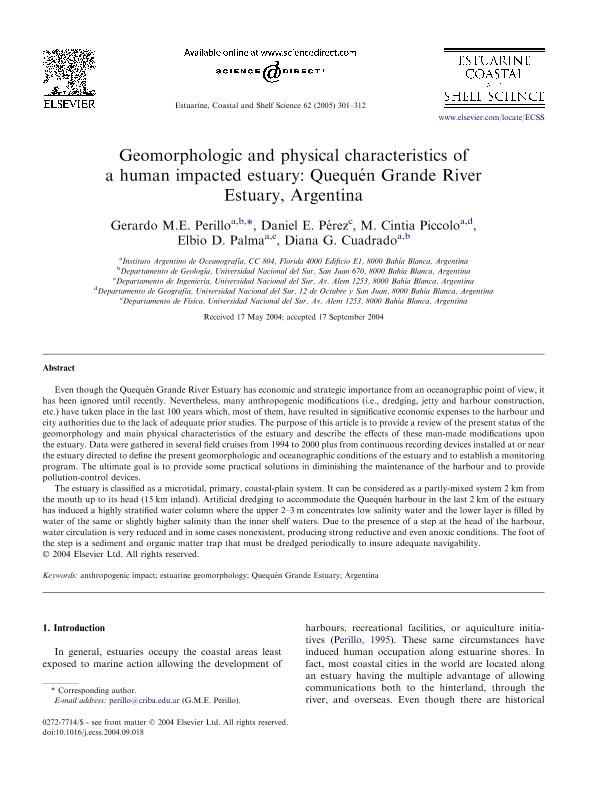Artículo
Geomorphologic and physical characteristics of a human impacted estuary: Quequén Grande River Estuary, Argentina
Perillo, Gerardo Miguel E. ; Pérez, Daniel Roberto; Piccolo, Maria Cintia
; Pérez, Daniel Roberto; Piccolo, Maria Cintia ; Palma, Elbio Daniel
; Palma, Elbio Daniel ; Cuadrado, Diana Graciela
; Cuadrado, Diana Graciela
 ; Pérez, Daniel Roberto; Piccolo, Maria Cintia
; Pérez, Daniel Roberto; Piccolo, Maria Cintia ; Palma, Elbio Daniel
; Palma, Elbio Daniel ; Cuadrado, Diana Graciela
; Cuadrado, Diana Graciela
Fecha de publicación:
12/2005
Editorial:
Academic Press Ltd - Elsevier Science Ltd
Revista:
Estuarine, Coastal and Shelf Science
ISSN:
0272-7714
Idioma:
Inglés
Tipo de recurso:
Artículo publicado
Clasificación temática:
Resumen
Even though the Quequén Grande River Estuary has economic and strategic importance from an oceanographic point of view, it has been ignored until recently. Nevertheless, many anthropogenic modifications (i.e., dredging, jetty and harbour construction, etc.) have taken place in the last 100 years which, most of them, have resulted in significative economic expenses to the harbour and city authorities due to the lack of adequate prior studies. The purpose of this article is to provide a review of the present status of the geomorphology and main physical characteristics of the estuary and describe the effects of these man-made modifications upon the estuary. Data were gathered in several field cruises from 1994 to 2000 plus from continuous recording devices installed at or near the estuary directed to define the present geomorphologic and oceanographic conditions of the estuary and to establish a monitoring program. The ultimate goal is to provide some practical solutions in diminishing the maintenance of the harbour and to provide pollution-control devices. The estuary is classified as a microtidal, primary, coastal-plain system. It can be considered as a partly-mixed system 2 km from the mouth up to its head (15 km inland). Artificial dredging to accommodate the Quequén harbour in the last 2 km of the estuary has induced a highly stratified water column where the upper 2-3 m concentrates low salinity water and the lower layer is filled by water of the same or slightly higher salinity than the inner shelf waters. Due to the presence of a step at the head of the harbour, water circulation is very reduced and in some cases nonexistent, producing strong reductive and even anoxic conditions. The foot of the step is a sediment and organic matter trap that must be dredged periodically to insure adequate navigability.
Archivos asociados
Licencia
Identificadores
Colecciones
Articulos(IADO)
Articulos de INST.ARG.DE OCEANOGRAFIA (I)
Articulos de INST.ARG.DE OCEANOGRAFIA (I)
Citación
Perillo, Gerardo Miguel E.; Pérez, Daniel Roberto; Piccolo, Maria Cintia; Palma, Elbio Daniel; Cuadrado, Diana Graciela; Geomorphologic and physical characteristics of a human impacted estuary: Quequén Grande River Estuary, Argentina; Academic Press Ltd - Elsevier Science Ltd; Estuarine, Coastal and Shelf Science; 62; 1-2; 12-2005; 301-312
Compartir
Altmétricas



